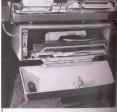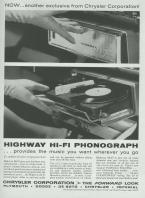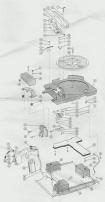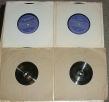
Open Nos Set

Rare Record Case

Auto Mechanics Mag

Pre-production tone arm?

magazine ad

Crysler demo

Service booklet

Dealer demo records
there were dealer demo records available that told the prospective customer about the new features of the car through the record player as they drove. I currently have the Chrysler and Dodge demo records in my collection. they are one sided and came in plain white sleeves! the dodge record carries the #ZR120 and the Chrysler record caries the #ZR122. I have seen one for the Plymouth and it carries the #ZR12? I have never heard of one for the Desoto series and I can't believe that it would be the only sereis that did not get one.
Test Records!
I never even knew that they exsisted until I found two of them. I had the good fortune to locate a Gentalman that used to work for Columbia records. He was hired by Peter Goldmark (inventor of the Highway HI-FI) after World War II and was one of the service techs that would service the units in the field when they were having problems. He still had a player that he had used to practice and approx. 18 records. When I bought out his collection i recieved the test records with the package deal. He could not remember what was on them and I do not have a player at home that runs 16 2/3 rpm and my car is far from finished. they came in plain brown sleeves and were single sided like the demo records but with no label at all. one has the #ZRD688-1B and the other is #ZRD688-1C the number is melted into the record with a small stamp near the middle.
Click here to see a full list of the records that were available to the general public!
The option died at the beginning of the 1957 model year. It does show
up in some early model year literature and service bulletins. But getting info about things
like the proper brackets to mount them in 1957 model cars is a difficult task. I have heard
reports of them showing up in cars up to 1959 but they were no longer a factory approved option
as of the first part of 1957. The dealer could have easily installed one in a later car as long
as it had the top of line radio with proper plug receptacle on the side. Why did the option die
so soon? If you read between the lines on the service bulletins related to the player you can
see that they had service problems. After a short time the dealers were to send customers to
authorized radio repair shops instead of trying to fix the units themselves. My suspicions are
that this was not an idiot-proof machine. The record skipped when we went over the railroad
tracks doing 90, must be something wrong with it! I don�t understand the road I use to go to
work was just paved in 1924 it�s not rough! They work fine on good roads and on decent highways
but lets face it you can�t go four wheeling with a record player and expect it not to skip!
Limited availability of records could not have helped either! Records had to be ordered from
Columbia records and of course only artists on contract with Columbia records were available!
Suggested additional reading material about the highway hi fi record player if you can find them!
Nov. 1955 popular science
Apr. 1956 radio and television news
Highway HI FI service
instructions
Maverick Inventor (Peter Goldmark)
Sams Photofact # 383-6
Chrysler corp. licked its wounds and tried again in 1960 this time the
unit was made by RCA the RCA victor. It played 45 rpm records. So those owners could go to the
local store and pick up a record for it not order through the mail. You could even get Elvis,
something that would never happened as long as Chrysler executives were picking out your
choices for you. You could stack up to 12 records at a time in the player so that you would not
have to change all the time! Take everything your home player would do and reverse it the
records loaded from the bottom. The tone arm would come up on the bottom of the record. As the
record was finished playing the tone arm would move out of the way, that record would drop to
the bottom of the spindle and the next record would start playing. This time the option lasted
a full 2 years 1960 and 1961 but I am sure it suffered the same problem as the first, skipping!
The next time you had a choice like this in a Chrysler corp. car was 1968? With 8 track tapes.

56 Desoto Install

Original Carry Case

Sams Flyer

Original stylus

Exploded view

Dodge demo

Demo/Test records


